Part II: The Japanese and Buddhism
1. Japanese Buddhism Today
Secularization of Japanese Society
Foreigners visiting Japan for the first time are likely to think that it is a completely secularized country. It appears to be so because the majority of Japanese seem to be indifferent to religious matters, except on special occasions such as festivals or funeral services. Particularly when young Japanese are asked about their religious beliefs or commitment, they tend to reply with an expression of astonishment or to smile uncomprehendingly. The older generation understands religion primarily as means of social unity or as an aid in life or suffering.
In most Japanese homes, a Buddhist altar and a Shinto shrine which are believed to protect the house and family respectively, stand side by side. When people purchase a car, they usually hang a charm in it. The charm may be one blessed by a Buddhist priest or a Shinto priest.
Neither Nor Situation of Buddhism and Shinto
According to a statistic issued by the Bureau of Cultural Affairs in the Japanese government in 2002, there are 95 million lay followers of Buddhism and a quarter million Buddhist priests and nuns with 86,000 institutions. It is interesting to note that when the 95 million Buddhist followers are added to an estimated 106 [million] Shinto followers, the total exceeds the total population of 120 million Japanese. These figures are taken from numbers registered at Buddhist temples and Shinto shrines. Therefore, this discrepancy may make little sense when analyzed in Western religious terms. However, it is not unusual for a Japanese person to belong to both institutions of Buddhism and Shintoism at the same time. Thus it appears that most Japanese have a minimal consciousness in regard to religion, at least in the terms of an “individual religion.”
Judging from the fact mentioned above, one may wonder whether or not the 95 million Buddhist followers are, in a true sense, Buddhists. When you ask any Japanese person, “Are you Buddhist?” the answer may be an ambiguous, “I may be so.” This does not mean that they are not followers of Buddhism. For many, such a question is similar to asking, “Are you good or pretty?” Likewise, most are rather hesitant to confirm or commit themselves to any particular religion. They do not want to confine themselves within the domain of any fixed form of religion, rather they tend to regard religion as a means of attaining and ever-renewing a higher state of being.
Complimentary Roles of Buddhism and Shinto
Approximately 80 percent of Japanese people get married in a Shinto or Christian ceremony and 90 percent hold Buddhist services for a funeral ceremony. For them, Shintoism plays the role of governing the joyous side of life and Buddhism the somber side. This syncretic tendency is so prevalent among the Japanese that which religion they belong to may seem confusing.
The variety of Japanese religiosity cannot be comprehended as an “either or” situation, as in the case of Christianity, Judaism, or Islam, but rather as an “as well as” situation. This all embracing nature has permeated Japanese life so deeply that religion appears to be virtually invisible, except when it surfaces at concrete events. Therefore, both Buddhism and Shintoism are like peaks of an iceberg which emerge above the surface of the sea; and yet they share a common background of the numinous, upon which the Japanese way of life is based.
Services Provided by Buddhist Temples
Ardent Japanese Buddhists have their family altar in the sitting room and chant the scriptures and offer flowers, water, and food to the main object of veneration enshrined there. They regard the family altar as a miniature temple of the heavens passed down from their parents to the oldest son of the family. Other sons and daughters set up their own altar when their parents pass away. For memorial or funereal services, they usually ask a priest to chant the scriptures on their behalf, either at the family altar or at the temple where their family graves are located. They then invite relatives or friends and share the service with them in order to strengthen their social ties centered around the deceased.
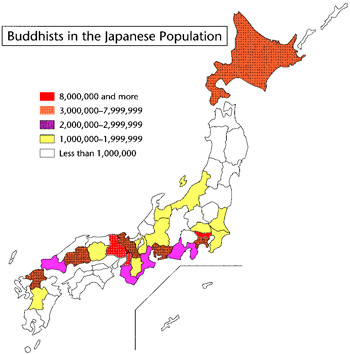
When people confront problems of life and death-whether spiritually, economically, or physically-they usually go to a temple and ask the priest for prayers to heal their wounded souls. Sometimes they make pilgrimages by visiting designated temples called fudasho and try to have their wishes fulfilled in that way. In rare cases, people have abandoned their family life for a certain period of time or even permanently to enter the priesthood and to receive religious training at a monastery.
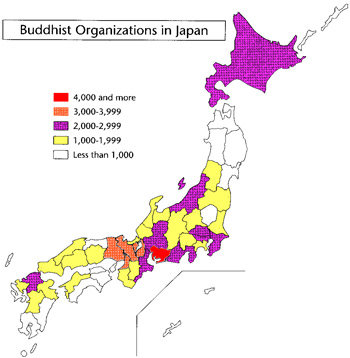
To comply with the different needs of the people, most temples today open their gates and offer a variety of activities to their members and visitors. A number of services are held: sunrise services, family services, Sunday services, memorial services, and wedding and funeral services. Various club activities are also held at the temple, such as hymn singing, meditation, dancing, tea ceremony, flower arrangement, handicrafts, calligraphy, judo, kendo, karate, and boy and girl scouts. Every means are taken to attract people to the temple and to bless them with the teachings of Buddhism.
Educating the Public about Buddhism
In the field of mass communications, Buddhist public lectures are offered either by the temple or by Buddhist organizations. Nationwide Buddhist programs are broadcast ever Sunday morning on television and radio. Newsletter, pamphlets, and leaflets are also distributed so that the activities of the temple or Buddhist organization can be made better known to the general public as well as their members.
Books and magazines on Buddhism are also being published in abundance and distributed to the public. Approximately 2,000 books on Buddhism were published in Japan in 2003 alone. Despite the fact that Japan is considered a Buddhist country and the majority of people belong to some Buddhist denomination, the religious content of Buddhism is not well known. In view of this pitiful condition, some Buddhist leaders are attempting to write more comprehensive books on Buddhism relevant to everyday life. Some of these books have become best sellers at major bookstores in Japan.
top of page
top of page
2. Buddhist Temples & the Japanese People
Profound Influence of Buddhism in Japan
In its long history, Buddhism has permeated Japanese life so thoroughly that it is difficult for us to recognize the depth and breadth of its influence. This can be clearly seen wherever you visit Japan and notice the innumerable Buddhist temples situated in the center of town or high in the mountains. Their abundance indicates the importance of the temples or at least the importance they held at one time. At first sight, these temples may look alike but there are some differences among them in. terms of their origin and function.
The first temple in Japan is believed to have been built in Asuka at the outskirts of Nara in A.D. 606 by the order of Empress Suiko. Thereafter, temples were built with the assistance and patronage of the state or various clans until the Kamakura period beginning in the 12th century. Priests were employed by them to console the souls of the deceased of the privileged class. However, in succeeding generations more temples were built with the aid of the newly arisen warrior and merchant classes which overcame the aristocratic class. During the Edo period in the 17th century, the Tokugawa shogunate forced all the members of a Japanese family to register as parishioners at the temple nearest them, regardless of whether they were believers of Buddhism or not.
The Official Status of Buddhism
This custom called the danka system continues even to this day, despite the fact that freedom of belief is ensured by the Japanese constitution. In the Edo period, temples were the religious and cultural centers of the community, offering education and even medical aid to those in need. However, at the time of the Meiji Restoration in 1868, Buddhism was suppressed by the ultranationalists and Shintoists, and a drastic change took place. Temples were obligated to be self-sufficient and lost much of their significance and influence.
This tendency was reinforced immediately after World War II, when the new constitution made clear the separation of state and religion. Even though temple properties are tax-exempt according to the Religious Corporation Law effective since the third of April of 1946, temples have required supplementary means of maintaining their ground and functions with the support of their congregations.
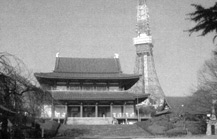
A Buddhist Temple in the middle of
modern citiscape of Tokyo
A Guide to Japanese Buddhism
At present, temples may be classified into four categories in terms of function, although there is no clear-cut demarcation among them: 1) temples which serve as a center for funeral and memorial services for the parishioners; 2) temples which serve as a center of prayer and healing; 3) temples which serve as a center of religious training for priests; and 4) temples which display their treasures to the public.
A temple in the first category is a place where the priest and his family reside and perform a multitude of religious and social services for the parishioners and the greater community. Until the Meiji Restoration of 1868, celibacy was strictly observed among priests, with the exception of those belonging to the Jodo Shin denomination of Pure Land Buddhism. However, at present, the majority of priests of any denomination marry and lead a family life at the temple. Conducting such services and maintaining the parishioners’ family graveyard provides the major source of income for priests who have a temple in this category. Sometimes these priests have supplementary jobs such as running a nursery school, a kindergarten, and a home for the elderly, and various other kinds of schools or work at a school or city office in the public sector.
A temple in the second category attracts visitors who ask the priest in charge for prayer and healing. Such temples belong mostly to the Nichiren denomination, or Shingon, Tendai, and other esoteric denominations. A priest who has undergone special religious training performs efficacious acts. People usually visit these temples individually, seeking practical benefits through prayer and healing.
A temple in the third category is called a monastery and is usually situated at the headquarters of each denomination. Priests and trainees reside together for a certain period of time and exercise their religious training as set forth by the denomination. These temples are sometimes off-limits to casual visitors.
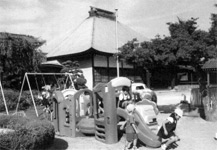
A kidergarten
on the grounds of a Temple
Temples in the fourth category are mostly situated in ancient cities such as Kyoto, Nara, or Kamakura where treasured sculptures, architecture, and gardens are preserved. Sometimes designated as national treasures or important cultural properties, they attract many visitors. Most of these temples charge an admission fee for viewing the treasures, which becomes a major source of income.
Improving Social Intercourse with Lay People
Most priests are born and raised in a temple and inherit their father’s profession as a priest. For this reason, they sometimes lack strong faith. People in turn are born into a Buddhist family and as long as they are registered at a temple, they are considered Buddhist. This proves to be a great hindrance to them for becoming true Buddhists with strong faith. Such people pay their respects to the various types of temples when the necessity arises and make use of temple properties according to their needs. The situation of Buddhist temples and their supporters being such, the raison d’etre of Buddhism as a living religion and a way of life is gradually losing its significance in society.
However, in view of this lack of social intercourse between the temple and the people, some conscientious priests have resolved to reactivate the original function of the temple by offering sermons, distributing pamphlets and books, and expressing their views on the problems of life and death to those who wish to listen. Some temples maintain schools, kindergartens, orphanages, hospitals, and homes for the elderly. Furthermore, an increasing number of city-dwellers at present visit temples at various occasions and are once again enjoying the quiet and serene atmosphere of temples, finding there peace of mind and a resting place in the midst of their bustling life in the concrete jungle.
top of page
3. Buddhist Rites of Passage in Traditional Japanese Life
Japanese Harmonization of Various Elements
It has generally been said that Japanese culture was stimulated by one foreign culture after another-Buddhist, Confucian, Daoist, European, and American—and made use of them as catalysts in its own formation. Throughout their history, the Japanese have consistently sought models outside Japan and created the composite whole of their culture by absorbing foreign elements rather than being swallowed by them. They have transformed and adapted them to their own needs and tastes rather than taking a single element as an absolute and excluding others.
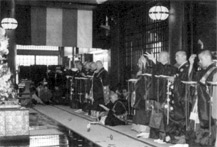
A memorial service for lay believers being
held in a Temple Grand Hall
This assimilationist tendency has been largely due to the fact that Japan is an isolated country which was unified very early as a nation with different ethnic groups (later on fused to one Yamato race) but one common language. I think that this pattern of retaining harmony within, while accepting new and different elements from outside open-mindedly, was nourished by the realistic and tolerant nature of the Japanese who have been constantly exposed to foreign elements.
a) Birth
For the Japanese, birth, marriage, and death are regarded as the three most important occasions in human life. Of these, birth and marriage are more or les affairs of the extended family, whereas services for the dead extend beyond these boundaries to include broader social connections. When a child is born, a report of the birth is issued by the hospital or midwife. This report is to be presented within two weeks to the city, town, or village office of the father’s permanent residence or present domicile, so that the child’s name will be properly entered in the family register called koseki. The first family feast, or Oshichiya, is held on the seventh day after the birth of a child, when the parents ordinarily take their newborn to a nearby or otherwise well-known Shinto shrine for the blessing of the birth by the guardian deities who are believed to protect and ensure the well-being of the baby. However, some ardent Buddhists take their infant to a temple or their ancestor’s grave, reporting and pledging to follow the teachings of the Buddha and the guidance of their ancestors.
b) Adulthood
In olden times, a rite to make one’s attainment of adulthood was held at home, but nowadays the coming of age is celebrated by many individual together at the public assembly hall of the community when their age of 20 is reached. From then on, one is considered an adult and given the right to vote.
Sometimes the confirmation ceremony is held at a Buddhist temple, and one is given a white cotton cloth on which is written the name of the Buddha. This ceremony is usually held at a special anniversary service or when the chief abbot is in attendance.
c) Marriage
To make a marriage legal in Japan, both partners must appear at the city or ward office and fill out the necessary forms. They must be accompanied by two or more adult witnesses or present documents signed by them. The husband will then be issued a new family register as the head of a new household when he registers the marriage.
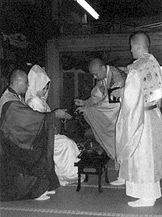
A Bride and Groom Sanctifying their Marraige
before a Buddhist Image by the ritual of drinking rice wine
In older times when the family system was strong, most marriages were arranged by the parents or go-betweens who assumed full responsibility for the marriage. This was especially true in the case of a daughter, for there was little occasion for young women to meet prospective husbands. Although the situation has changed nowadays, and as young people have a greater opportunity to meet each other, the old manner of arranging marriages declined rapidly.
The typical Japanese wedding is a Shinto ceremony, but there are increasing numbers of Buddhist, Christian, and secular weddings. A certificate of marriage making it legal is not obtained from the officiating priest but rather from the government office. The wedding is held at a regular Shinto shrine, Buddhist temple, or Christian church, or in front of a shrine set up in a ceremonial hall, attended by only the families and close relatives of the couple.
A Buddhist wedding ceremony is solemnly initiated with a vow to the Buddha followed by the wedding procession. After the offering of incense to the Buddha, the couple receives water ritually purified by the officiating priest, then drinks sacred rice wine offered to the Buddha from three wine cups, the bride and groom drinking three times each, symbolizing homage to the three treasures of the Buddha. This is called drinking the san-san-kudo (three times three equaling nine sips) pledge. The juzu, or Buddhist rosary, is usually given to the couple, and the wedding rings are exchanged at this time. After the pledge is confirmed by the officiating priest, the wedding is over and everyone attending retires from the ceremonial hall.
After the wedding ceremony, there is a reception for relatives and friends which is usually held in a reception hall in a hotel, a club, or the home. For the newly married couple, this is a valuable steppingstone to future friendship and social relations.
d) Death
In Japan, when there is a death, a death certificate is issued by the doctor in a hospital by filling out the proper form, with the family filling in such information as next of kin. In the case of a death at home or a traffic accident, the form is issued by an attending doctor, police officer, or police medical authority. The complete form is to be presented immediately to the city, town, or village office, which then issues a permit for the cremation or burial of the deceased 24 hours after death. Since most local government by-laws and regulations presently prohibit burial, most are cremated in Japan. The cremated remains are then interred in family graves or temple repositories.
The undertaker handles all the details of a funeral, including the preparation of the body, the location of the wake, the funeral ceremony itself, and the arrangements with the crematorium. It is customary for a family to choose one person as their representative to make the funeral arrangement with the undertaker and the priest in charge, who will explain the prices of the various services available. In general, the factors affecting the cost are the numbers of priests in attendance, the length of the service, the number of prayers offered, the complexity of the Buddhist posthumous name (called kaimyo), the size of the altar, and to a lesser degree, the coffin.
At the funeral service, held either at home or at the temple, all the people concerned are invited along with the priest in charge to solemnly pay their last respects to the deceased. In most cases, the funeral service takes one hour. Afterward, the coffin is carried to the hearse which proceeds to the crematorium. It takes one to one and a half hours for cremation. The relatives then gather the bones ashes and place them in a container to be buried under a tombstone or enshrined in the repository of a temple. A wooden tablet (called ihai) on which the Buddhist posthumous name is written is given to the bereaved family. On the 49th day after the death, a service is reverently observed at home or at a temple, for it is believed that by the 49th day the karma of the deceased takes a new form. Thereafter, a memorial service is held at home or at the temple on the anniversary of the death every year, or on the third, seventh, 13th, 17th, 23rd or 33rd year, respectively.
top of page
4. Buddhist Influences on Japanese Culture
Buddhism in Daily Life
Buddhism as a living religion is not a system of dogma or temple buildings, but a way of life. It is not a mystical or speculative experience which only qualified persons can acquire but a spontaneous experience manifested in daily life and accessible to anyone, regardless of sex, position, ideology, or character. In this sense, we can see the Buddhist influence among the Japanese people in various aspects of their way of life. The following are some of the examples which can be singled out in daily life as distinctly Buddhist.
a) Grace at Meals
Almost all Japanese express their thankfulness when they take meals. “Itadakimasu” is the word spoken before meals, meaning “With thankfulness, I accept this meal by reflecting on my own work, to see whether I deserve it.” After meals, one says “gochisosama,” which means “May this offering be well received to keep my body in good health and to fulfill the good wishes of all beings.” Although the original meaning is completely lost and such words are automatically uttered, they convey the profound Buddhist teaching of thankfulness to all beings who give them life in this world. When ardent Buddhists say these words, they put their hands together in prayer called gassho.
b) Daily Greetings
The Japanese often express their gratitude by saying “arigato” which literally means “I am obliged” and express their regret by saying “sumimasen” which means “excuse me:’ One might say “sumimasen” having just had one’s cigarette lit by a stranger, instead of “arigato.” Logic tells us that there is no need to feel sorry for getting what one wants, but the Japanese feel very strongly about obligations to others, and this feeling permeates their vocabulary. By saying “sumimasen,” one acknowledges that one has not yet properly reciprocated the other’s kindness. Foreigners will encounter this sort of politeness and thoughtfulness often when they meet Japanese people.
c) The Game of Janken (Scissors, Paper, Rock)
Janken is perhaps the most popular game which the Japanese, young and old, play when deciding a trivial issue. It is played by thrusting forth the right hand simultaneously with the other player and extending or curling the fingers and thumb to represent the shape of scissors, paper, or rock. Scissors defeat paper because a pair of scissors can cut paper; rock beats scissors because scissors cannot cut rock; and paper defeats rock because it can be wrapped around a rock. This game conveys the profound Buddhist teaching of interdependence and relativeness.
d) Furoshiki (Japanese Wrapping Cloth)
Furoshiki, a handy piece of cloth for wrapping up and carrying almost anything, is used by the Japanese in their everyday life. A square piece of any fabric will make a furoshiki which can be folded up and put into one’s pocket or bag when not in use. It can also be used as a rope when twisted. Likewise, Japanese socks, obi waist sashes, kimono, wooden clogs, or slippers have flexible usage and can be made to fit almost anyone. Such multipurposefulness of things Japanese reminds one of the Mahayana Buddhist teaching of no outer-limitation or extension.
e) Daruma Dolls
The Japanese are very fond of the stout and round Daruma dolls which always rebound upright. These Daruma dolls are symbols of good luck and are usually purchased during the New Year’s festival with their eyes not yet painted in. One eye is painted at the time of praying for a particular wish and if the wish comes true, the second eye is painted in.
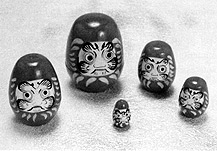
Daruma Dolls serve as good luck charms
In this way, the Daruma’s eyes are finally opened. The dolls come in all sizes and are made after the famous Indian Buddhist monk, Bodhidharma, the founder of Zen Buddhism in China who is reputed to have lost his legs after sitting for eight years in meditation. The popular saying, “stumbling seven times and righting oneself eight like Daruma;” is attributed to the legend of Bodhidharma, who endured all kinds of hardships and never gave up.
f) Origami (Folding Paper Figures)
Unlike Japanese painting, gardens, or flower arrangement, origami follows a precise and determined pattern governed by the mechanics of folding and by the shape which is to be constructed.

In Origami many shapes can be made
with a single sheet of paper
Various paper models of cranes, boats, flowers, desks, boxes, and trays can be made by folding colored paper. The design derives from the intricate pattern of lines and paper surfaces meeting at various angles to form an object. Although paper itself is perishable, the idea of immortalizing such an ephemeral substance by universalizing its shape is distinctly Buddhist.
g) Furo (The Japanese Bath)
Perhaps no other people are as fond of taking baths as the Japanese. They take a bath at least once a day, usually right before going to bed. While the custom of taking a bath properly started early in Japanese history for reasons of health and sanitation, it was given additional impetus after the introduction of Buddhism in the sixth century. In Buddhism, cleanliness is next to godliness, which connected bathing with ablution and purification. It is no doubt that the abundance of hot springs in the volcanic islands of Japan encouraged this custom of taking baths.
top of page
5. Major Annual Buddhist Festivals
Annual Buddhist Events in Japan
Below is a list of the annual events held at most Buddhist temples in Japan, followed by a short explanation of each event.
January 1st: Shusho Service (New Year’s Day)
February 3rd: Setsubun Service (The Heralding of Spring)
February 15th: Nehan Service (The Buddha’s Nirvana)
March 21st and September 23rd*:
Higan Service (Spring and Fall Equinox)
April 8th: Hana Matsuri (The Birth of the Buddha)
July 15th: O-Bon (Buddhist Memorial Day)
Summer: Segaki Service (Buddhist Thanksgiving)
December 8th: Jodo Service (The Buddha’s Enlightenment)
December 31st: Joya Service (New Year’s Eve)
(*Note: Spring and Fall Equinox Days vary from year to year according to the revolution of the earth around the sun.)
a) Shusho Service (New Year’s Day)
On New Year’s Day, the average Japanese person makes it a practice to wake up early and, if possible, watch the first sunrise. A spiced rice wine (toso) and pounded rice cakes (mochi) are served at breakfast for the first three days as a means of praying for longevity and health. One pays a visit to a nearby, or otherwise well-known, Buddhist temple or shrine wearing formal clothes and makes courtesy calls on friends and relatives.
The Shusho New Year’s Service is held with solemnity at a Buddhist temple for a safe passage in the coming year. In 2003, 86 million Japanese people visited Buddhist temples and Shinto shrines from New Year’s Eve through January 3rd. This figure is 1,310,000 higher than for the comparable period a year ago. The Meiji Jingu shrine in Tokyo was the most crowded with an estimated three million visitors, followed by the Naritasan Shinsho-ji temple in Chiba Prefecture.
b) Setsubun Service (The Heralding of Spring)
On February 3rd, the day before the beginning of spring according to the Japanese lunar calendar, the Setsubun Service involving the throwing of beans is held at homes, temples, and shrines during the daytime. On this day, roasted beans are placed in square wooden containers for measuring rice and thrown at doorways and in rooms with the participants shouting, “Out with the devil, in with good fortune!”
At major temples and shrines, the task of scattering the beans goes to celebrated persons such as politicians or movie stars born in whatever zodiacal year it happens to be. Hundreds of thousands of well-wishers sharing this happy occasion attend.
c) Nehan Service (The Buddha’s Nirvana)
Unlike the Theravadins in Southeast Asian countries, who celebrate the Buddha’s birth, enlightenment, and nirvana at the same time on Wesak Day in May, Japanese Buddhists celebrate these events separately according to the Mahayana tradition. February 15th is believed to be the day of nehan (parinirvana), on which Guatama Buddha passed away from this world about 2,500 years ago at Kushinara, India.
At a Buddhist temple, the Nehan Service is held with a hanging scroll depicting the Buddha’s passing away into nirvana surrounded with many disciples, and even animals, weeping over his death.
d) Higan Service (Spring and Fall Equinox)
Higan is the Buddhist festival which falls in March and September for a week. The middle of the week is the vernal and autumnal equinox day, respectively, meaning that on this day the length of time for day and night is equal. This heralds the new season, as expressed by the Japanese phrase, “The heat or cold extends until Higan.” We find in it renewed hope after long and weary days of cold or heat.
In all Buddhist temples, the Higan Service is celebrated to remind us of the impermanence of life. Higan means “the other shore” and seems to be derived from the Sanskrit word paramita. It indicates “the state in which one has gone to the other shore after practicing the six paramitas, namely the virtues of giving, morality, patience, energy, meditation, and wisdom. The other shore symbolizes nirvana in contrast to this shore, the mundane world of samsara.”
The celebration of the Higan Service is believed to have started in Japan some 1,200 years ago. According to historical records, in the 25th year of the Enryaku era (A.D. 806), the Japanese government ordered the priests of the Kokubun-ji temples, established by the government in every province throughout Japan, to recite the Diamond Sutra at this time of year. During this period, it is customary for Buddhists throughout the country to visit temples and graves. They bring flowers, incense, water or their favorite food to be to be offered to the deceased and greet them with refreshed minds to report on their well-being. At this time also, devout Buddhists begin a pilgrimage to various temples designated as stations. Such visits originated with Kobo Daishi Kukai (774–835), the founder of the Shingon school, on Shikoku island where a large number of pilgrims can still be seen journeying from one temple to another. Dressed in white, they make the journey ringing handbells and chanting sacred verses of a sutra in chorus.
e) Hana Matsuri (The Birth of the Buddha)
Christmas, celebrating the birth of Jesus, is the most joyous day for the Christian. Likewise, Hana Matsuri (Flower Festival), celebrating the birth of Gautama Buddha, is the happiest day for the Japanese Buddhist. On this day, the Kambutsu Service is held at the temple to celebrate the Buddha’s birth, with a flower-covered shrine set up in the assembly hall.
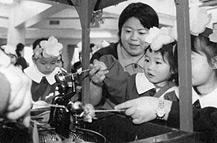
Children blessing the statuette of new born Shakyamuni
with a sweet tea water in a celebration of his birth
In China, the first celebration of the Buddha’s birth is said to have taken place on April 8th in the latter Chao dynasty (A.D. 319–355) and in Japan it was first held in 660 at the Ganko-ji temple near Nara by order of Empress Suiko. On this day, the statue of the infant Buddha is placed in a flower-decorated shrine symbolizing the beautiful Lumbini garden where the Buddha was born. Sometimes it is carried on a white elephant in a parade suggesting the elephant that brought the Buddha from heaven to the womb of his mother, Queen Maya. People gather around the shrine and pour sweet tea on the statue of the infant Buddha as a substitute for the nectar which is said to have been sprinkled by celestial beings at the time of his birth. The service is therefore called the Kambutsu (Anointing the Buddha) Service.
f) O-Bon (Buddhist Memorial Day)
The word O-Bon is an abbreviation of Ura-Bon from the Sanskrit ullambana which literally means “hung upside down.” It implies the terrible suffering which is felt, physically or spiritually, when one is hung upside down.
Legend tells us that in India there was a man called Maudgalyayana (Mokuren in Japanese), who became on of the Buddha’s disciples and gained deep insight into the nature of existence. To his surprise he found his dead mother, thin and desiccated, in the state of ullambana yearning for food and water. He immediately brought some to her, but she could not partake of them because at the moment she was about to consume them, they turned into fire. The astonished son hurried back to the Buddha to recount what happened and asked why she had to suffer so. The Buddha quietly answered that it was inevitable, for no one had taken care of her before and after her death. Maudgalyana felt contrition for the selfishness he had had before he became the Buddha’s disciple, for he had been egocentric and taking care of no one but himself.
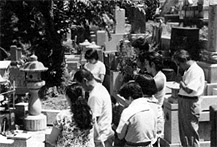
Visiting graves during O-Bon is a
regular custom for many
When Maudgalyayana begged the Buddha for a way to rescue his mother, the Buddha advised him to summon all the monks nearby and hold a memorial service for her by offering food, clothing, and other necessities to the monks and the whole congregation. The Buddha further advised that July 15th would be the best time to hold the service, as all of the monks came out of their summer retreat on this day, spiritually cleansed and refreshed. The disciple was very much relieved and held the service as advised by the Buddha and finally saved his mother from hunger and isolation in the other world.
Usually O-Bon services take place for four days beginning from July 13th. They are conducted by a priest in front of a special altar in Buddhist homes, where spirits of ancestors are believed to visit during this season. The first day of O-Bon is called Mukae-Bon or the welcoming day and the last day is called Okuri-Bon or the farewell day. On the eve of the Mukae-Bon, people go to the graveyard carrying beautiful lanterns and welcome the spirits of their ancestors back to their home. Horses and bullocks made of cucumbers and eggplants with legs of dried grass are prepared in front of the tombstone for them to mount. At home, people enjoy a happy reunion with the spirits by holding a special feast with cakes, fresh fruit, and vegetables. On the last day of O-Bon, people send off the spirits in a miniature boat (called shoryobune) filled with all kinds of foods or with a lighted lantern. It is said that the boats will cross the ocean and reach the other shore safely so that until the next O-Bon, the spirits need never feel hungry nor lonesome in the other world.
g) Segaki Service (Buddhist Thanksgiving)
Segaki literally means the offering to those who are in desperate need. The Segaki Service usually falls on the day when all the members of the temple gather together to offer food or money to those who are in need.
According to the Mahaparinirvana Sutra, Ananda, one of the Buddhas disciples, was in agony when a devil appeared and predicted that he would die in a few days. Astonished, Ananda asked the devil if there was any way to escape his fate, and the devil replied that he would be safe if he offered food and propounded the noble teaching. According to the sutra, he did so and was saved. This teaches the importance of giving to others who are in desperate need. This thanksgiving service is sometimes held at the time of the memorial services for the deceased, so that the attendants may be reminded of giving something to others besides their own ancestors.
h) Jodo Service (The Buddha’s Enlightenment)
The Jodo Service falls on December 8th, the day on which Guatama Buddha was believed to have achieved full enlightened under the Bodhi tree at Buddhagaya and became the Buddha, the Supremely Awakened One.
After Gautama left his father’s palace, he spent six long years in search of truth. He visited various ascetics and mystics who were detached from this world and exercised austere discipline. They taught the spiritual supremacy over materialism by tormenting their bodies to the point of attaining the highest state of mind, where they would become one with God. So too did Gautama, yet in his pain and hunger he could not gain anything but the miserable existence of his mind and body. He wandered around and more intensely sought a solution which could satisfy him. However, he failed to find any solution in the existing ideas and exercises.
When Gautama reached the river Nairanjana, he found a good place in the forest for meditation. After he sat down there, darkness descended all around him and Mara, the master of sensual pleasure, tempted him severeal times to give up his austere discipline. Gautama struggled and finally drove Mara away, but fainted because of hunger and fatigue. When he awoke, he saw a country girl, Sujata, passing by and accepted a bowl of curds from her, for he realized that a healthy mind could not be sustained in a body that was weak and ill. He went to bathe in a nearby river and sat in meditation under the Bodhi tree, strengthened and refreshed. He deeply recognized at this moment that neither materialism (self-indulgence) nor the extreme of spirituality (self-mortification) is the way of deliverance from the fetters of this world, but rather the Middle Way, the balancing and transcendence of both materialism and spirituality. He finally found this way at the age of 35 and was born anew from that time on. He came out of the forest fully enlightened and began to preach what he had found.
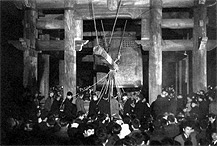
Ringing the bell on New Year's Eve
lends a poetic touch at years end
The Jodo Service celebrating Gautama’s enlightenment is held at Buddhist temples or public halls, reminding us of its significance in the contemporary world.
i) Joya Service (New Year’s Eve)
It is common practice to eat buckwheat noodles on New Year’s Eve. One theory is that this custom began with the hope that eating noodles at the turn of the year would extend one’s life like the long length of the noodles. Another theory is that it originated with merchants who were so busy collecting bills on this day that they ate noodles, since it takes little time to prepare and eat them.
At the stroke of midnight, the sound of bells ringing 108 times is heard from the nearby temples or is sometimes even broadcast. This symbolizes the expulsion of the 108 human defilements believed to have accumulated in the past year. Sometimes the bell tower of the temple is surrounded by hundreds of thousands of people who wish to hear the bells and wait for the coming New Year. Many people stay awake this night and, as soon as they hear the toll of the temple bells, start out on their New Year’s pilgrimage to specific temple or shrines.

|
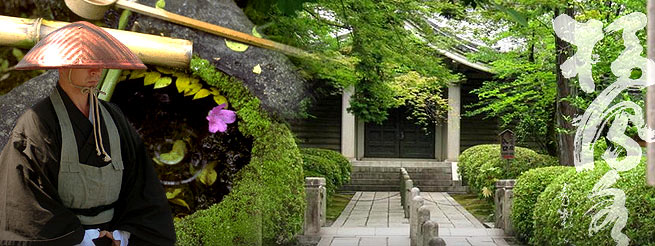

![]()

